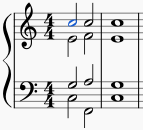 Today in the Blogging A-to-Z challenge, I've used a bit of sleight-of-hand to sneak in a discussion of a large topic by highlighting one example of it.
Today in the Blogging A-to-Z challenge, I've used a bit of sleight-of-hand to sneak in a discussion of a large topic by highlighting one example of it.
A cadence resolves or pauses a musical phrase. The simplest cadence, called the authentic cadence, uses only the 1st and 5th notes of the scale:

You have a C major chord, followed by a G major chord, ending in a C major chord: tonic, dominant, tonic; I-V-I. (If you need a refresher on what those terms mean, read Monday's post.)
The second-most-common cadence shows up a lot in church music. Technically called the plagal cadence, it won't surprise you to learn people often call it the "amen cadence:"

Only the second chord has changed, from G to F; the progression is now tonic, subdominant, tonic (I-IV-I).
Music theory has identified probably a dozen or so other cadences, but let's take a look at one more common one, the deceptive cadence. It deceives you by setting up an authentic cadence (I-V-I) but instead of landing back on the tonic, it resolves to the submediant, giving us I-V-vi:

The deceptive cadence pauses, but doesn't resolve completely; it wants to go on, kind of like the semicolon that paused this sentence. So let's resolve it:

See? All resolved. (And for those keeping score [ah, ha ha] at home, the analysis is essentially I-V-vi; ii-V-I, with some passing notes interspersed. I'll explain how some of this works next Tuesday.)